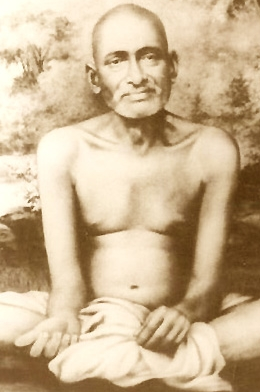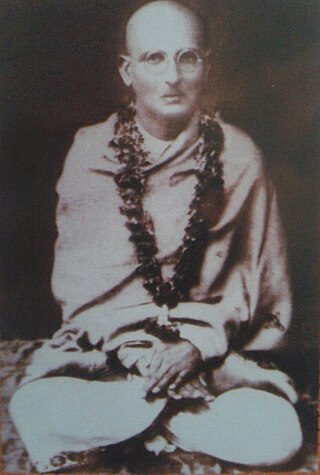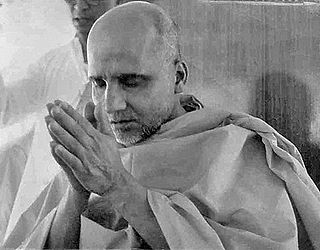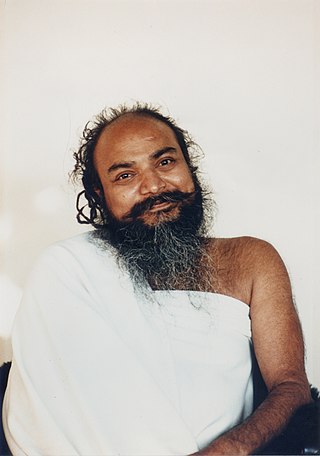
Sivananda Saraswati was a yoga guru, a Hindu spiritual teacher, and a proponent of Vedanta. Sivananda was born in Pattamadai, in the Tirunelveli district of Tamil Nadu, and was named Kuppuswami. He studied medicine and served in British Malaya as a physician for several years before taking up monasticism.
Hans Rām Singh Rawat, called Shrī Hans Jī Mahārāj and by various other honorifics, was an Indian religious leader.
Surat Shabd Simran is a type of spiritual meditation in the Sant Mat tradition.

Ramananda or Swami Ramanand was a 14th-century Vaishnava devotional poet saint, who lived in the Gangetic basin of northern India. The Hindu tradition recognizes him as the founder of the Ramanandi Sampradaya, the largest monastic Hindu renunciant community in modern times.

Gajanan Maharaj was an Indian Hindu guru, saint and mystic. His origins remain uncertain. He first appeared at Shegaon, a village in Buldhana district, Maharashtra, as a young man aged 30, probably on 23 February 1878. He attained Sanjeevana Samadhi on September 8, 1910, which is thought to be a process of voluntary withdrawal from one's physical body. This date of his Samadhi is commemorated every year as part of the Shree Punyatithi Utsav. The date of his first appearance is considered an auspicious day and is celebrated as Prakat Din Sohla.

Radha Soami is a spiritual tradition or faith founded by Shiv Dayal Singh in 1861 on Basant Panchami Day in Agra, India.

Born Shri Beli Ram Ji, Shri Swami Swarupanand Ji Maharaj, was an Indian Guru of Shri Paramhans Advait Mat lineage. He is also known as "Shri Nangli Niwasi Bhagwaan Ji", as "Hari Har Baba", as "Sadhgurudev Ji" and as "Second Guru". Born in the village of Teri in Kohat district, India, he was initiated into the sanyasas in the early 1900s in Teri by Shri Paramhans Swami Advaitanand Ji, who named him Shri Swami Swarupanand Ji. During Swami Advaitanand ji's life, Swami Swarupanand ji created an order of sanyasis in northern India and founded several centers with the purpose of disseminating his master's teachings.

Dasanami (IAST Daśanāmī Saṃpradāya "Tradition of Ten Names"), also known as the Order of Swamis, is a Hindu monastic tradition of "single-staff renunciation" generally associated with the four cardinal mathas of the Advaita Vedanta tradition and, according to tradition, organized in its present form by Vedic scholar and teacher Adi Shankaracharya.

Advait Mat or Paramhans Advait Mat is a cluster of panths in northern India. It was founded by Shri Swami Advaitanand Ji Maharaj (1846-1919) who is also known as Paramhans Dyal Ji Maharaj. He declared Swami Swarupanand Ji Maharaj as his spiritual successor. Swami Swarupanand Ji Maharaj founded more than 300 ashrams with the purpose of disseminating his master's teachings. Swami Swarupanand Ji Maharaj had initiated more than thousand of his disciples into the sanyas. Many of his disciples went on to establish spiritual institutions to spread the same knowledge.

Swami Krishnananda Saraswati was a disciple of Sivananda Saraswati and served as the General Secretary of the Divine Life Society in Rishikesh, India from 1958 until 2001. Author of more than 40 texts, and lecturing extensively, on yoga, religion, and metaphysics, Krishnananda was a prolific theologian, saint, yogi and philosopher.

The Swaminarayan Sampradaya, also known as Swaminarayan Hinduism and Swaminarayan movement, is a Hindu Vaishnava sampradaya rooted in Ramanuja's Vishishtadvaita, characterized by the worship of its charismatic founder Sahajanand Swami, better known as Swaminarayan (1781–1830), as an avatar of Krishna or as the highest manifestation of Purushottam, the supreme God. According to the tradition's lore, both the religious group and Sahajanand Swami became known as Swaminarayan after the Swaminarayan mantra, which is a compound of two Sanskrit words, swami and Narayan.

Shri Shivabalayogi Maharaj was a yogi who claimed to have attained self-realization through twelve years of arduous tapas, meditating in samādhi for an average of twenty hours a day.

Jangama dhyana is a meditation technique which has been practiced by various sages over the centuries. In recent times, this technique was widely taught in India and around the world by Shri Shivabalayogi Maharaj, who experienced a spiritual vision in which the manifestation of a Jangama sage instructed him in this technique of meditation to achieve self-realization. Jangama means 'eternal existence' and dhyana means 'meditation.' Hence Jangama dhyana is 'Meditation on the Eternal Existence .'
Bhava Samadhi is a state of ecstatic consciousness that can sometimes be a seemingly spontaneous experience, but is recognized generally to be the culmination of long periods of devotional practices. It is believed by some groups to be evoked through the presence of "higher beings." "Bhava" means "feeling", "emotion", "mood", "mental attitude" or "devotional state of mind." "Samadhi" is a state of consciousness in which the mind becomes completely still and the consciousness of the experiencing subject becomes one with the experienced object. Thus, "bhava samadhi" denotes an advanced spiritual state in which the emotions of the mind are channelled into one-pointed concentration and the practitioner experiences devotional ecstasy. Bhava samadhi has been experienced by notable figures in Indian spiritual history, including Sri Ramakrishna Paramahamsa and some of his disciples, Chaitanya Mahaprabhu and his chief disciple Nityananda, Mirabai, Kundalini Guru Shri Anandi Ma, and numerous saints in the bhakti tradition.

Maharshi Mehi Paramhans is a saint in the tradition of Sant Mat. He is usually known as 'Gurumaharaj'. He was the guru of 'Akhil Bhartiye Santmat Satsang'. He studied Vedas, main Upanishads, the Bhagavad Gita, the Bible, different sutras of Buddhism, the Quran, saint's literature and from this assessed that the essential teaching contained in all of these is one and the same. He gave one and easiest method to attain 'Moksha'. They are 'Satsang' and 'Dhyan'(Meditation). Mehi was a direct disciple of Baba Devi Sahab of Muradabad, Uttar Pradesh.

Shri Paramhans Swami Advaitanand Ji Maharaj, also known as Shri Paramhans Dayal Maharaj Ji, was born in Chhapra City, India. Shri is known as the "First Spiritual Master" of the Shri Paramhans Advait Mat, while also initiated the "Second Master" and Shri Swami Swarupanand Ji Maharaj in the early 1900s.

Shri Tridandi Swami was a Sri Vaishnava saint and one of the foremost preachers of the Sri Vaishnava Sampradaya in North India. One of the foremost disciples of Sri Prativadibhayankar Swamiji of Kanchi, he popularized Sri Vaishnavism throughout North India among the masses and brought Sri Vaishnavism beyond its traditional domain of South India. After Sri Rangadeshika Swamiji, who founded the Ranganathji temple in the mid-19th century, he can rightly be counted amongst the most noteworthy Acharyas of Sri Vaishnava sampradaya.

Swami Vivekananda was a Hindu monk from India. His teachings and philosophy are a reinterpretation and synthesis of various strands of Hindu thought, most notably classical yoga and (Advaita) Vedanta, with western esotericism and Universalism. He blended religion with nationalism, and applied this reinterpretation to various aspect's of education, faith, character building as well as social issues pertaining to India. His influence extended also to the west, and he was instrumental in introducing Yoga to the west.
Satyarthi is an Indian surname that may refer to















